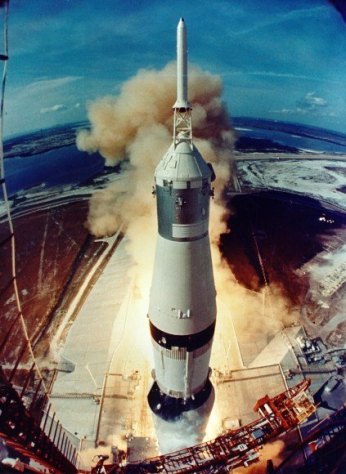On May 25, 1961, President John F. Kennedy delivered a message before a joint session of Congress, articulating a goal of “landing a man on the moon and returning him safely to the earth” by the end of the decade.
Though he wouldn’t live to see it, Kennedy’s pledge would be realized forty-nine years ago on this day: July 20, 1969.
 Today, the accomplishments of the Apollo series of spacecraft seem foreordained, the massive complexities of the undertaking, forgotten.
Today, the accomplishments of the Apollo series of spacecraft seem foreordained, the massive complexities of the undertaking, forgotten.
In the modern era, the most powerful supercomputers on earth put the Hubble Space Telescope into orbit, with “vision” literally requiring correction. With “glasses”.
These guys were sending human beings 240,000 miles into space, to land on the moon and come back again, on computing “horsepower” equivalent to modern pocket calculators.
Any one of countless calculations could have misfired, slinging three astronauts into the black void of space, there to spend eternity, in a flying tomb.
 The 363′, 6,698,700-pound Saturn V launch vehicle lifted off from the John F. Kennedy Space Center on Merritt Island, Florida on July 16, carrying mission commander Neil Armstrong, Lunar module pilot Edwin “Buzz” Aldrin, and Command Module Michael Collins.
The 363′, 6,698,700-pound Saturn V launch vehicle lifted off from the John F. Kennedy Space Center on Merritt Island, Florida on July 16, carrying mission commander Neil Armstrong, Lunar module pilot Edwin “Buzz” Aldrin, and Command Module Michael Collins.
The Apollo spacecraft consisted of three components: a Command Module (CM) with a cabin for the three astronauts, a Service Module (SM) supporting the CM with propulsion, electrical power, oxygen, and water; and a Lunar Module (LM) for landing on the Moon. The vehicle was launched toward the moon by a Saturn V rocket, designed to break apart as each of a series of rocket stages were exhausted, and separated from the main craft.
The Command/Service Module passed behind the moon at 12:21 Eastern Standard Time on July 19, firing its service propulsion engine and inserting the craft into lunar orbit.

Aldrin and Armstrong next moved into the LM, the only component to actually land on the lunar surface, with Collins remaining to orbit the moon in the CM.

The pair landed on a flat plain called the “Sea of Tranquility” on this day in 1969 at 4:18pm EST. Half the world heard the words “Tranquility base, the eagle has landed”. Neil Armstrong stepped onto the lunar surface six hours later, with the words “That’s one small step for [a] man, one giant leap for mankind”.
 These first two humans to set foot on the moon spent about 2½ hours on the surface. The pair collected nearly 50-lbs of material for transport back to earth, planting the American flag where it most likely remains, to this day.
These first two humans to set foot on the moon spent about 2½ hours on the surface. The pair collected nearly 50-lbs of material for transport back to earth, planting the American flag where it most likely remains, to this day.
Two days earlier, White House speechwriter William Safire had written an address, a speech to be delivered by President Richard Nixon, in case of failure. Twenty-five years earlier on the eve of the D-Day invasion, General Dwight D. Eisenhower penned a letter, taking personal responsibility for the mission’s failure. Like Eisenhower’s letter, President Nixon’s speech was never delivered. The speech was entitled, “IN EVENT OF MOON DISASTER”
“Fate has ordained that the men who went to the moon to explore in peace will stay on the moon to rest in peace.
These brave men, Neil Armstrong and Edwin Aldrin, know that there is no hope for their recovery. But they also know that there is hope for mankind in their sacrifice.
These two men are laying down their lives in mankind’s most noble goal: the search for truth and understanding”…
The course of events envisioned by Richard Nixon’s speech writer, never came to be. The upper part of the Lunar Module lifted off 21½ hours later, returning Armstrong and Aldrin to the Command Module. Armstrong, Aldrin and Collins returned to earth and splashed down in the Pacific Ocean on July 24. Three astronauts had made history. The United States had had the last word in the space race, with the Soviet Union.




Good Luck Mr Gorsky!
LikeLiked by 1 person
Simply wonderful, Rick. I hadn’t realised the anniversary and hadn’t considered – though it is obvious, and standard practice for such things – the failure speech. Thank God it worked. I can just about remember watching it live on TV, though didn’t really take in the magnitude of the achievement until much later, of course. Excellent research and nicely told, as usual!
LikeLiked by 1 person
Thank you Mike, for your kind comments. I was thirteen at the time and had little idea of the magnitude of the accomplishment. This day brought the whole world together, I think, in a way that few others could.
LikeLiked by 1 person
I believe Pink Floyd were the house band on TV coverage of the lunar landing over here..!
LikeLiked by 1 person
For real? I couldn’t Love that , more! Pink Floyd would be the one band’s music I would bring with me to that proverbial desert island, since I was about fifteen.
LikeLike